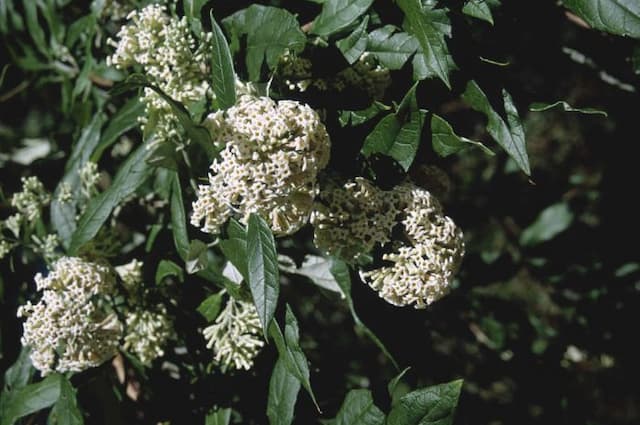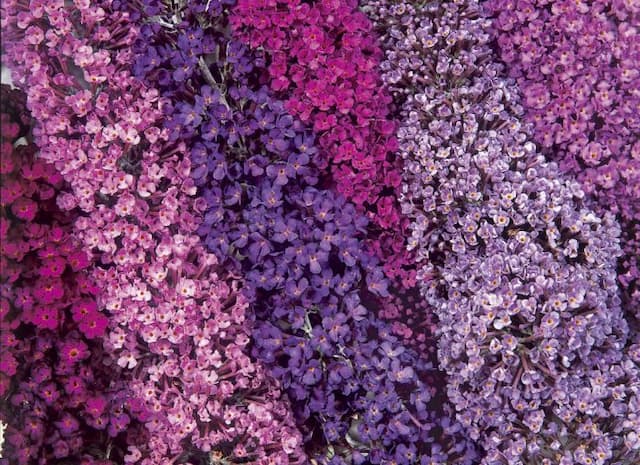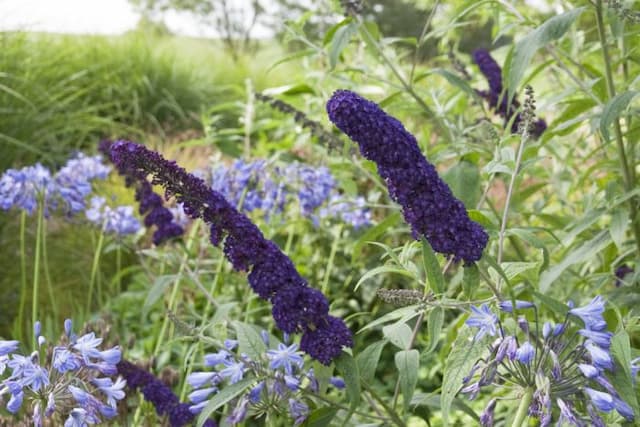Nemesia Nemesia Berries and Cream = 'Fleurbac' (PBR)

ABOUT
The Nemesia Berries and Cream 'Fleurbac' is a visually striking plant known for its charming and colorful flowers. The blooms evoke the delightful blend of berries and cream, exhibiting a palette that combines shades of deep purples, pinks, and white, with some being frosted with a creamy white edging that perfectly complements the darker tones. These vibrant flowers are typically shaped like small snapdragons, bearing a resemblance to intricately fashioned faces with upper and lower petals; some might have a speckled or bi-colored appearance that adds an extra layer of depth to their visual appeal. The plant itself presents a lush backdrop for these stunning flowers, composed of bushy green foliage, which are the leaves that provide a vivid contrast to the rich colors of the blossoms. Each group of flowers and leaves emerges from the branching stems that create a rounded and full overall form. The entire display of the Nemesia Berries and Cream 'Fleurbac' exudes a soft and romantic aesthetic, making it a popular choice for adding a splash of color to gardens and outdoor spaces.
About this plant
 Names
NamesSynonyms
Berries and Cream Nemesia, Fleurbac Nemesia.
Common names
Nemesia Berries and Cream = 'Fleurbac' (PBR)
 Toxicity
ToxicityTo humans
Nemesia is generally not known to be toxic to humans. However, as with many ornamental plants, it is not intended for ingestion, and eating the plant could potentially cause mild stomach upset due to the plant's natural compounds. While there is no widespread information on severe toxicity, it is always best to avoid eating ornamental plants and to keep them out of reach of small children who might ingest them out of curiosity.
To pets
Nemesia is not commonly listed as a toxic plant to pets such as dogs and cats. However, ingestion of non-food plants can sometimes lead to gastrointestinal upset in animals, leading to symptoms such as vomiting or diarrhea. If you suspect your pet has ingested a substantial amount of the plant and is showing signs of distress, it is recommended to consult with a veterinarian.
 Characteristics
CharacteristicsLife cycle
Annuals
Foliage type
Evergreen
Color of leaves
Green
Flower color
Mixed
Height
1 foot (0.3 meters)
Spread
1 foot (0.3 meters)
Plant type
Herb
Hardiness zones
9
Native area
South Africa
Benefits
 General Benefits
General Benefits- Attractive Blossoms: Offers a profusion of striking, bicolor flowers that can enhance the visual appeal of gardens and landscapes.
- Long Blooming Period: It has a long flowering season, generally from late spring to fall, providing sustained color in outdoor spaces.
- Easy to Grow: Known for being low maintenance and easy to cultivate, making it suitable for gardeners of all skill levels.
- Compact Size: With its neat, compact growth habit, it is ideal for containers, hanging baskets, and small garden spaces.
- Versatile Use: Can be used in various garden designs, from borders and edging to mass plantings or as a colorful groundcover.
- Pollinator-Friendly: Attracts bees and butterflies, promoting biodiversity and a healthy ecosystem in the garden.
- Cold Tolerant: Able to withstand cooler temperatures, making it suitable for a variety of climates and extending its growing season in some regions.
 Medical Properties
Medical PropertiesThis plant is not used for medical purposes.
 Air-purifying Qualities
Air-purifying QualitiesThis plant is not specifically known for air purifying qualities.
 Other Uses
Other Uses- Photography Prop: Nemesia can be used as a vibrant prop for photographers looking to add natural beauty and a pop of color to their floral photography sessions.
- Education Aid: These plants can be used for educational purposes, such as teaching children or gardening enthusiasts about plant growth, pollination, and the care of annual flowers.
- Artistic Inspiration: The unique appearance of Nemesia Berries and Cream can serve as inspiration for artists and can be used as a live model for paintings and drawings.
- Themed Events: Can be used to create a whimsical or fairytale-themed setting for events like weddings, garden parties, or other celebrations due to its bicolored blooms.
- Culinary Decoration: Although not consumable, the blooms can be used to decorate dessert trays or drink stations at a buffet for an added touch of elegance.
- Fashion Accessories: The flowers might be used by designers to inspire patterns or even as delicate natural accessories in fashion shows or photo shoots.
- Memorial Plant: Nemesia could symbolize remembrance and used in planting projects for memorial gardens or spaces dedicated to lost loved ones.
- Handicrafts: The flowers and foliage of Nemesia could be used in crafting projects such as pressed flower art or for embellishing handmade greeting cards.
- Miniature Gardens: Due to their compact size, Nemesia plants can be included in miniature garden or fairy garden arrangements.
- Seasonal Decor: The vibrant flowers can be incorporated into seasonal decor, especially for spring and summer, to add a fresh and festive feel to indoor and outdoor spaces.
Interesting Facts
 Feng Shui
Feng ShuiNemesia is not used in Feng Shui practice.
 Zodiac Sign Compitability
Zodiac Sign CompitabilityNemesia is not used in astrology practice.
 Plant Symbolism
Plant Symbolism- Delight and Pleasure: Nemesia plants are known for their sweet fragrance and delightful blooms, symbolizing life's simple pleasures and joys.
- Friendship: The colorful display of Nemesia flowers can represent friendship and the sharing of good times with others.
- Success and Good Fortune: With their lush, abundant growth, Nemesia flowers may be associated with wishes for success and prosperity.
 Water
WaterNemesia prefers consistently moist soil but not waterlogged conditions. Water the plant thoroughly when the top inch of soil feels dry to the touch, which typically means watering once every 5 to 7 days depending on the climate and weather conditions. It's best to water in the morning to allow the foliage to dry out during the day, reducing the risk of disease. Ensure that the plant receives about 1 to 1.5 gallons of water per watering session, allowing for deeper root growth and healthier plants.
 Light
LightNemesia, including the 'Berries and Cream' variety, thrives in full sun to partial shade conditions. They perform best when they receive at least 6 to 8 hours of sunlight daily. A location that offers morning sunlight with some afternoon shade would be ideal, especially in regions with very hot summers.
 Temperature
TemperatureNemesia 'Berries and Cream' prefers moderate temperatures ranging from 55°F to 75°F for optimal growth. While they can tolerate cooler nights down to around 30°F, frost can be damaging, so it's best to protect them or bring them indoors when temperatures approach freezing. These plants will struggle in conditions above 80°F, so provide some shade during the hottest part of the day.
 Pruning
PruningRegular deadheading of spent flowers encourages Nemesia 'Berries and Cream' to produce more blooms. Prune lightly throughout the blooming season to maintain shape and remove any yellowing or damaged foliage. The best time for pruning is when the flowers start to fade, which can vary depending on local climate conditions but generally occurs every 2 to 3 weeks during active growth.
 Cleaning
CleaningAs needed
 Soil
SoilFor Nemesia 'Berries and Cream', the best soil mix is well-draining with plenty of organic matter such as peat or compost; it should be light and fluffy. This plant prefers a slightly acidic to neutral soil pH, ideally between 5.5 and 7. Regular mulching can help maintain soil moisture and temperature.
 Repotting
RepottingNemesia 'Berries and Cream' generally doesn't require frequent repotting. Repot once every 1 to 2 years or when the plant has outgrown its current container to maintain health and vigor.
 Humidity & Misting
Humidity & MistingNemesia 'Berries and Cream' thrives best in environments with moderate humidity. Aim for a humidity level of around 40-60% for optimal growth.
 Suitable locations
Suitable locationsIndoor
Place in bright, indirect light and keep soil consistently moist.
Outdoor
Plant in full sun to partial shade in well-draining soil.
Hardiness zone
9-10 USDA
 Life cycle
Life cycleThe Nemesia 'Berries and Cream' begins its life cycle when its seeds germinate in early spring under the right conditions of warmth and moisture. After germination, the seedlings grow rapidly, developing a rosette of leaves and a strong root system. As the weather warms, it enters the vegetative stage, producing stems and more leaves, preparing for the blooming stage. Flowering occurs in late spring or early summer, displaying its characteristic bi-colored flowers that attract pollinators. After pollination, the plant sets seeds, completing its reproductive cycle. If conditions permit, it can exhibit a perennial habit, otherwise, it completes its life cycle in one growing season, dying after the seeds have matured and dispersed.
 Propogation
PropogationPropogation time
Spring to Summer
The Nemesia Berries and Cream, known botanically as 'Fleurbac' (PBR), is generally propagated through seed or vegetative cuttings. The most popular method is by seed, which should be sown in late winter to early spring under a light covering of soil. Ensure a consistent temperature of around 64 to 70°F (18 to 21°C) for optimal germination. Light is necessary for the process, so the seeds should not be buried too deep. Once the seedlings have developed a couple of true leaves, they can be transplanted to individual pots and hardened off before being planted out after the danger of frost has passed.



![Butterfly bush [Adonis Blue]](/_next/image?url=https%3A%2F%2Fplants-admin.emdemapps.com%2Fimages%2Fplants%2F%2Fimages%2F604b56e58f983.png&w=640&q=75)


![Butterfly bush [Buzz Ivory]](/_next/image?url=https%3A%2F%2Fplants-admin.emdemapps.com%2Fimages%2Fplants%2F%2Fimages%2F604b57987dfa8.png&w=640&q=75)
![Butterfly bush [Camberwell Beauty]](/_next/image?url=https%3A%2F%2Fplants-admin.emdemapps.com%2Fimages%2Fplants%2F%2Fimages%2F604b5ead04c12.png&w=640&q=75)

